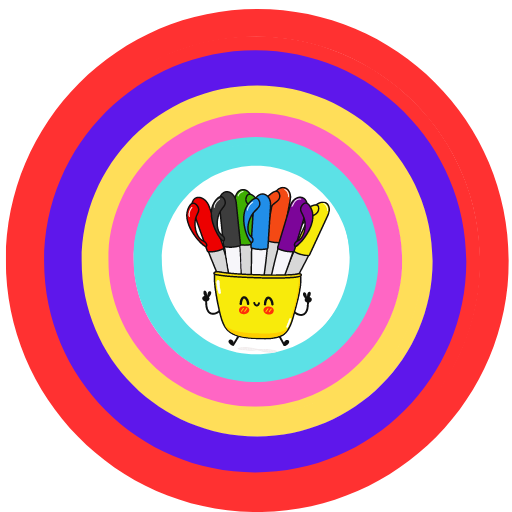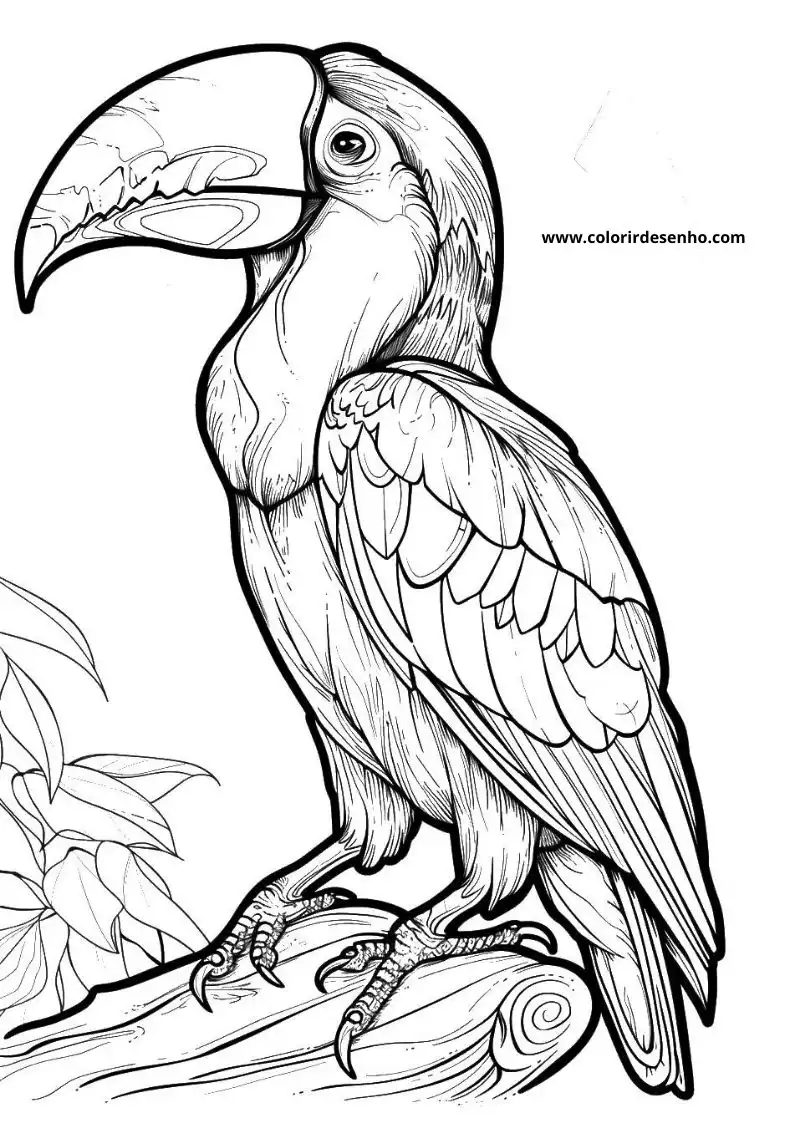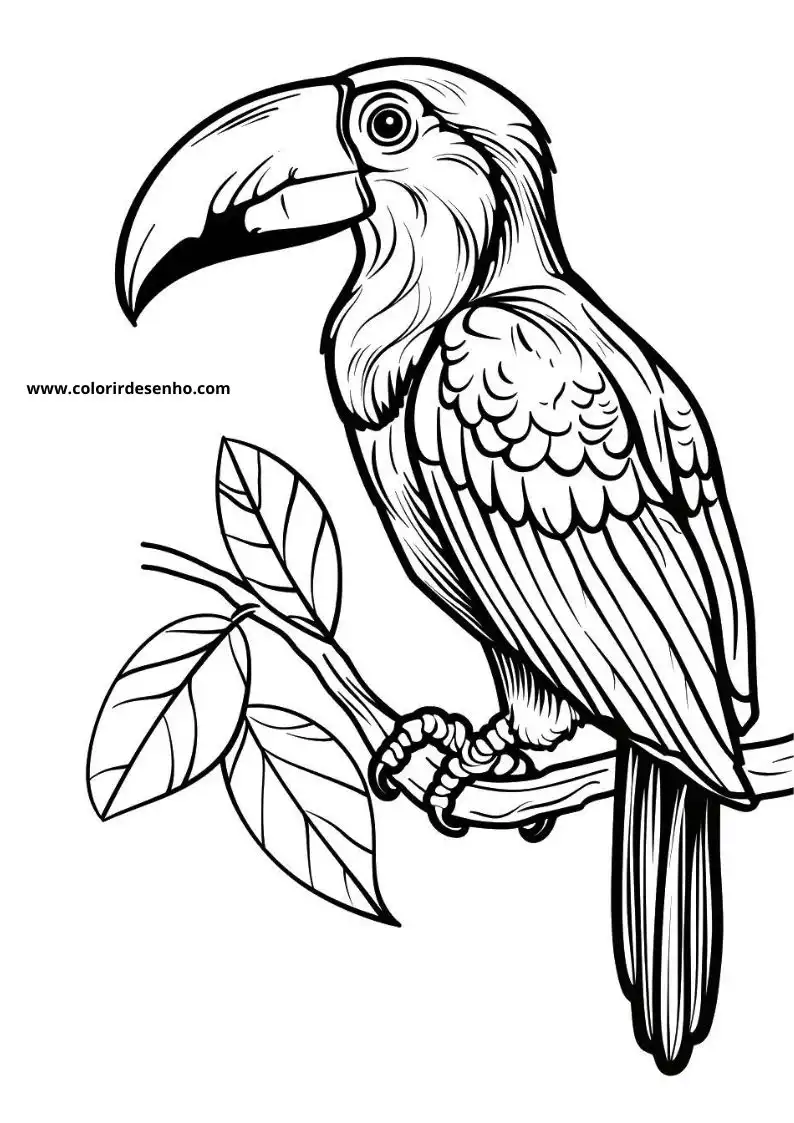Toucan Coloring Pages - 79 Coloring Sheets to Print
Toucan Coloring Pages are a fantastic way to engage children in a fun and educational activity. If you’re looking for a way to explore the exotic beauty of toucans through drawings, you’ve come to the right place. A toucan coloring page is an excellent method to keep the little ones entertained while they connect with nature and develop their artistic skills. Here, you’ll find an incredible selection of realistic toucan coloring sheets to print, perfect for all ages.
Toucan Coloring Sheets: Explore the Exotic World of Toucans
Toucan Coloring Pages captivate the imagination with their vibrant colors and fascinating features. When we think of vibrant and intriguing birds, toucans are undoubtedly among the first that come to mind. With their colorful beaks and charming personalities, they are a perfect theme for painting activities. Whether it’s for a quiet afternoon at home or an educational activity at school, printable toucan coloring pages are always a great choice. And the best part? You can easily find free printable toucan coloring pages and start the fun right away!

THE COLORING PICTURES ARE AT THE BOTTOM OF THE PAGE, WHEN YOU OPEN THE PICTURE, CLICK ON THE SAVE BUTTON ABOVE THE PICTURE.
Curious Facts About Toucans
Toucans are birds full of peculiarities, and getting to know them better makes the experience of coloring even richer. These birds, with their impressive beaks and colorful plumage, are true works of art in nature. Let’s explore some curiosities that make toucans so special.
The Origin and Habitat of Toucans
Toucans are found in the tropical regions of Central and South America, especially in dense and humid forests. They are quite adaptable and can live both in lowland areas and mountainous forests. Despite preferring dense forests, some species of toucans can also be found in semi-open areas like savannas and woodlands.
The habitat of toucans plays a fundamental role in their lives. The tropical forests provide a rich environment full of food, such as fruits, which are the basis of the toucans’ diet. Additionally, the dense vegetation offers refuge from predators and suitable places for reproduction. Unfortunately, the destruction of these natural habitats, mainly due to deforestation and agricultural expansion, has caused a significant decline in toucan populations.
The Toucan's Beak: Beauty and Functionality
The beak of the toucan is undoubtedly its most iconic feature. Although it appears large and heavy, it’s actually quite light because it’s made of keratin with a hollow internal structure. This design allows the beak to be strong enough to crush fruits and light enough not to hinder flight. Moreover, the toucan’s beak also helps in thermoregulation, releasing heat when necessary.
But the toucan’s beak goes beyond its practical function; it also plays an important role in attracting mates. In many toucan species, the size and color of the beak are indicators of health and vigor, making it a crucial factor during mate selection. Additionally, the toucan’s beak is used in mating rituals, where the birds engage in a kind of “dance” that includes touching and synchronized movements.
Behavior and Diet of Toucans
Beyond their striking appearance, the behavior of toucans is equally fascinating. They are social birds with varied eating habits, which contributes to their survival in different environments.
Social Life of Toucans
Toucans enjoy living in small groups, usually formed by six to eight individuals. They are known for their vocal communication, using a series of calls and whistles to communicate with each other. These sounds also help to ward off predators and establish territory.
Group living offers toucans a complex social network where they constantly interact, whether sharing food or participating in social activities like mutual grooming. This social behavior strengthens the bonds between group members and is crucial for their survival in challenging environments.
The Diverse Diet of Toucans
Although predominantly frugivorous, toucans don’t limit themselves to just fruits. Their diet also includes insects, small reptiles, and even eggs of other birds. Their long beaks and tongues allow them to reach fruits and other foods in hard-to-access places. Additionally, toucans play a crucial role in seed dispersal, helping to maintain the ecosystem of tropical forests.
Observing toucans feeding is fascinating. They use their beaks to reach fruits on thin branches, often grabbing the fruit at the tip of the beak before tossing it back into their mouth with an agile head movement. This ability is particularly useful in dense forests, where food may be hidden in places hard for other birds to access.
Ecological Importance and Conservation of Toucans
Toucans are not just a visual attraction in tropical forests; they play a vital role in the ecological balance of these environments. However, like many other species, they face threats that jeopardize their survival.
Toucans as Seed Dispersers
One of the most important ecological functions of toucans is seed dispersal. By feeding on fruits, they end up spreading the seeds through their feces in different parts of the forest. This process helps regenerate deforested areas and maintains the biodiversity of the forest.
The seed dispersal performed by toucans is essential for the maintenance of tropical forests. Without these birds, many plants would struggle to spread, which could lead to a reduction in plant diversity. This symbiotic relationship between toucans and fruit trees exemplifies how species depend on each other to survive.
Threats and Conservation Efforts
Unfortunately, toucans are increasingly threatened due to the destruction of their natural habitat and the illegal wildlife trade. Deforestation, mainly for agriculture and urbanization, reduces the areas available for these birds to live and reproduce. To protect toucans, continuous conservation efforts are essential, both in combating animal trafficking and in preserving tropical forests.
Climate change represents another significant threat. Rising temperatures and changes in precipitation patterns can affect the availability of food and suitable habitats, placing more pressure on toucan populations. Conservation programs focusing on habitat restoration and the creation of protected areas are fundamental to ensuring the future of these birds.
The Diversity of Toucan Species
There are about 40 species of toucans, each with its own characteristics and peculiarities. This diversity makes these birds fascinating and attracts the attention of scientists and nature enthusiasts alike.
The Toco Toucan: The Giant of the Species
The Toco Toucan (Ramphastos toco) is the largest and most well-known toucan species. It can be easily identified by its large orange beak with a black spot at the tip. Found mainly in subtropical forests and savannas, it’s one of the most adaptable and widely distributed species.
The Toco Toucan is also one of the most studied toucan species. Its behavior, diet, and social interactions are well documented, making it a model for better understanding the ecology and conservation of toucans as a whole. Its large size and striking coloration make it a popular attraction in zoos and wildlife parks worldwide.
The Green-billed Toucan: A Peculiar Species
The Green-billed Toucan (Ramphastos dicolorus) is smaller than the Toco Toucan but equally impressive. Its beak is green, as the name suggests, and its plumage varies between black, white, and red. This species prefers dense forests and is more difficult to spot due to its more isolated habitat.
Adapted to the Atlantic Forest environment, one of the most biodiverse yet threatened tropical forests globally, the conservation of the Green-billed Toucan is closely linked to efforts to protect this rich ecosystem. Preserving its habitat is crucial for the survival of this unique species.
Other Notable Toucan Species
Other notable species include the Keel-billed Toucan (Ramphastos sulfuratus), known for its multicolored beak, and the Yellow-throated Toucan (Ramphastos ambiguus), which has predominantly black plumage with a bright yellow chest. Each of these species has its own evolutionary history and unique adaptations that make them perfectly suited to their respective habitats.
Toucan Coloring Pages offer a delightful way to explore the exotic world of these fascinating birds. Whether you’re printing toucan coloring sheets to print for a fun activity or simply appreciating the natural beauty of toucans, there’s always something new to learn about these incredible creatures. So grab your coloring tools and dive into the vibrant world of printable toucan coloring pages. Not only will you be engaging in a fun activity, but you’ll also contribute to raising awareness and appreciation for these remarkable birds. Enjoy your artistic journey with free printable toucan coloring pages and let your creativity soar!


















































































